Tracking Down Ned Kelly
Tracking down Ned Kelly and searching for the place where he murdered three policemen on 26 October 1878 ended in a history scoop.
Clouds hung low over the Wombat Ranges making visibility poor and driving conditions hazardous, but this atmosphere seemed perfect for tracking down the scene of a murderous event.
Misty rain persisted after heavy downfalls in the early morning and it became colder the further into the ranges we drove. As far as we could tell we were the only ones willing to brave the elements and head into the bush that day. We passed no other cars and no other people in the wet and gloomy conditions.
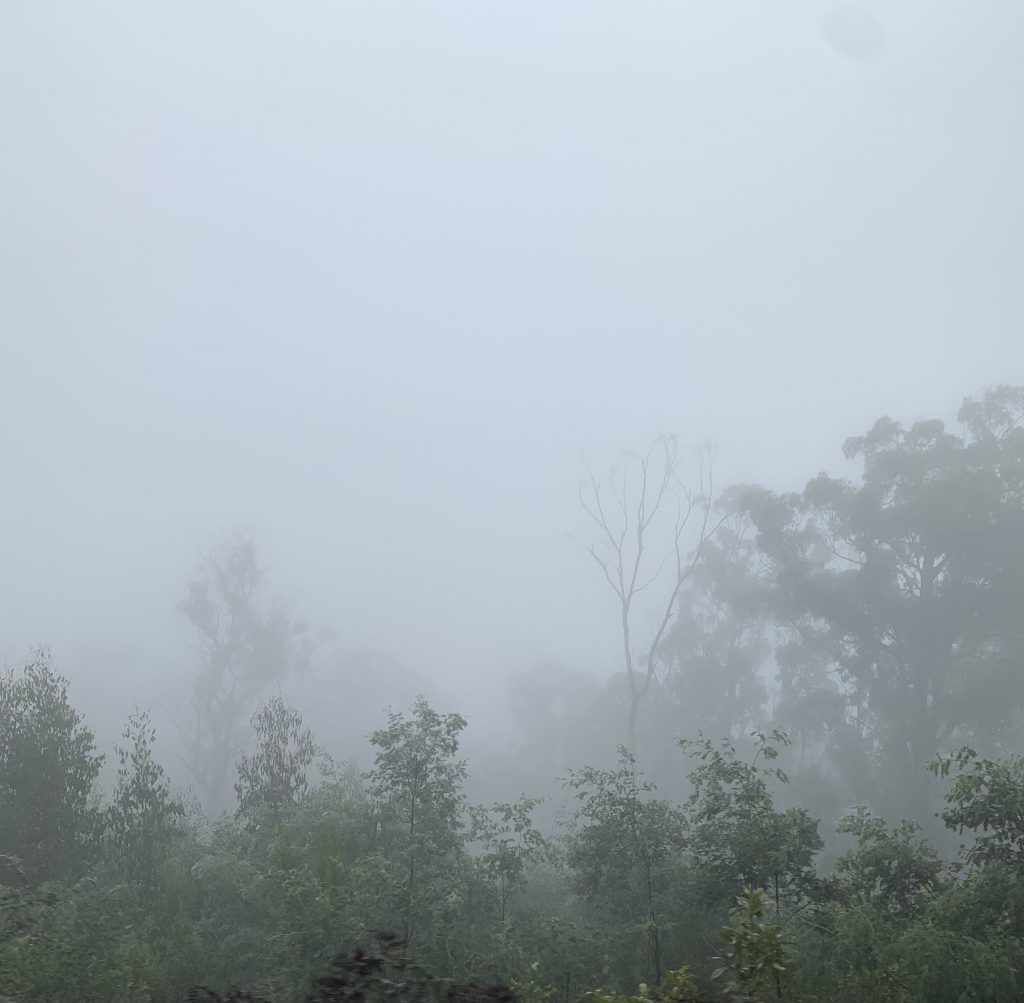
Stringybark Creek – Not An Easy Place To Find
Stringybark Creek, or specifically the Stringybark Creek Historic Memorial (erected in 2018) where the murders took place, was not easy to find. Google Maps was mischievous that day, intent on taking us on the windiest, remotest, and spookiest route from the City of Wangaratta. We were taken off the main Wangaratta-Whitfield road onto Boggy Creek road, Fifteen Mile Creek road and then Madhouse road. Madhouse road! There must be a reason for this unsettling road name and probably not a good one.
An abandoned looking house appeared as we rounded a bend. Was this the Mad House? The driver wouldn’t stop so I could take a photograph, he said it was too dangerous on a tight road in wet and misty conditions. Madhouse road went on and on eventually ending at a junction which we thought was at the Stringybark Creek road.
Google advised us to “turn left” which we did, and drove for several kilometres, until Google said we had reached our destination – the Stringybark Creek Historic Memorial. But there was no memorial. There was nothing but a vacant fenced paddock. I thought we were back in Ireland for just a second and that wasn’t because of the weather.
Thinking the historic area must be somewhere nearby, the fearless driver turned the car around and using his innate sense of direction, rather than Google, eventually found the Stringybark Camping area and soon after the Historic Memorial.
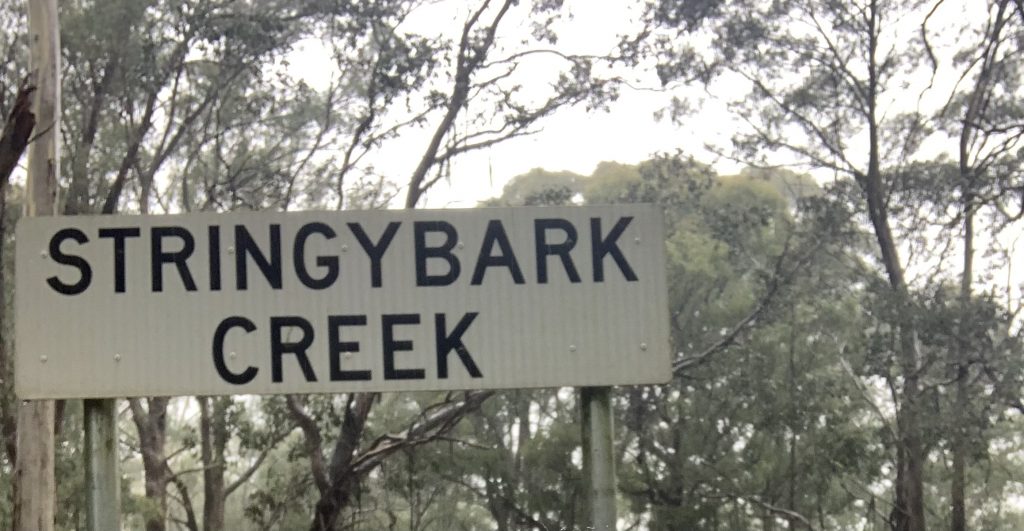
The Stringybark Creek Memorial Site
In 2018 a new memorial was erected at Stringybark Creek to remember the three policemen who were murdered so viciously on 26 October 1878.
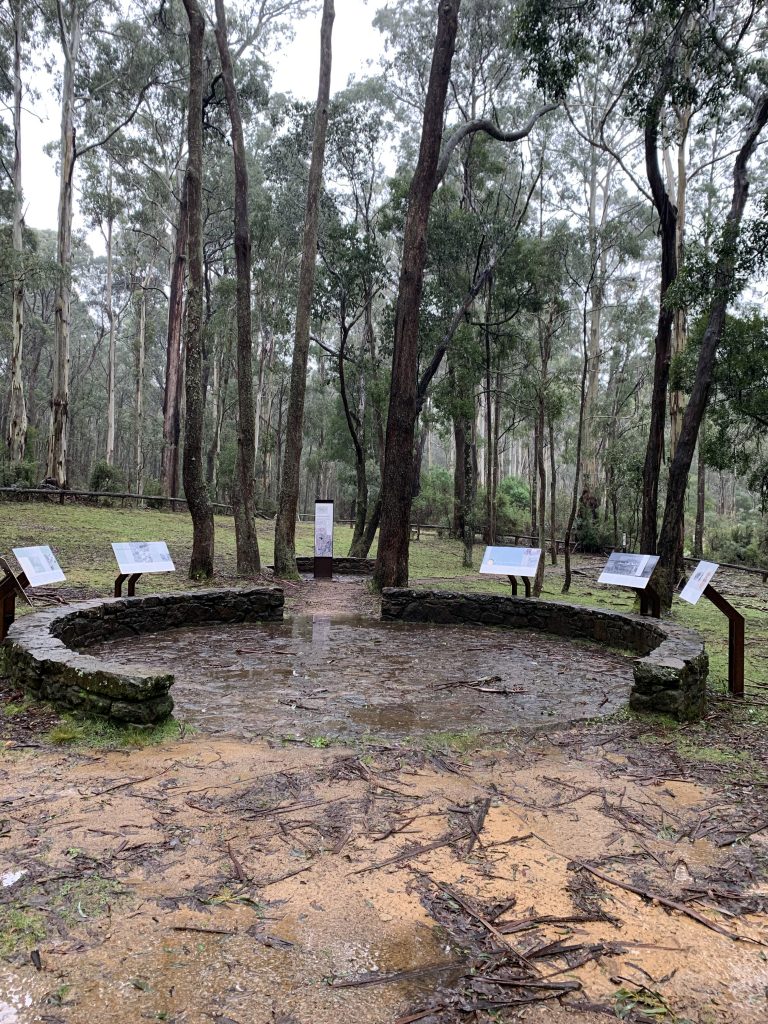
Back Tracking. Memorials Need to Have Correct Dates
The murders of three police officers, Sergeant Michael Kennedy and Constables Thomas Lonigan and Michael Scanlon by Ned Kelly at Stringybark Creek occurred on 26 October 1878. The murders did NOT occur on 25 October 1878 as recorded by the Victorian Police Museum.
The National Police Memorial in Canberra even gets the date wrong. Under the name of each police officer their plaque reads: “Stringybark Creek … Victoria … 25 October 1878”.
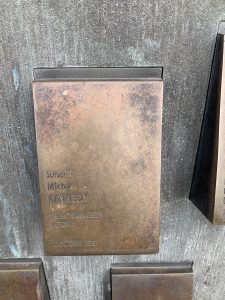
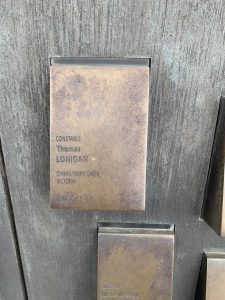
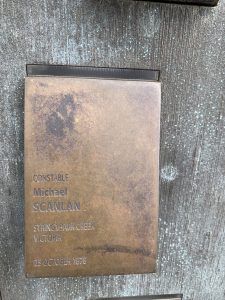
In Mansfield Cemetery the officers’ headstones, erected by the Parliament of Victoria, each say they were murdered: ” … on 26th October, 1878.”
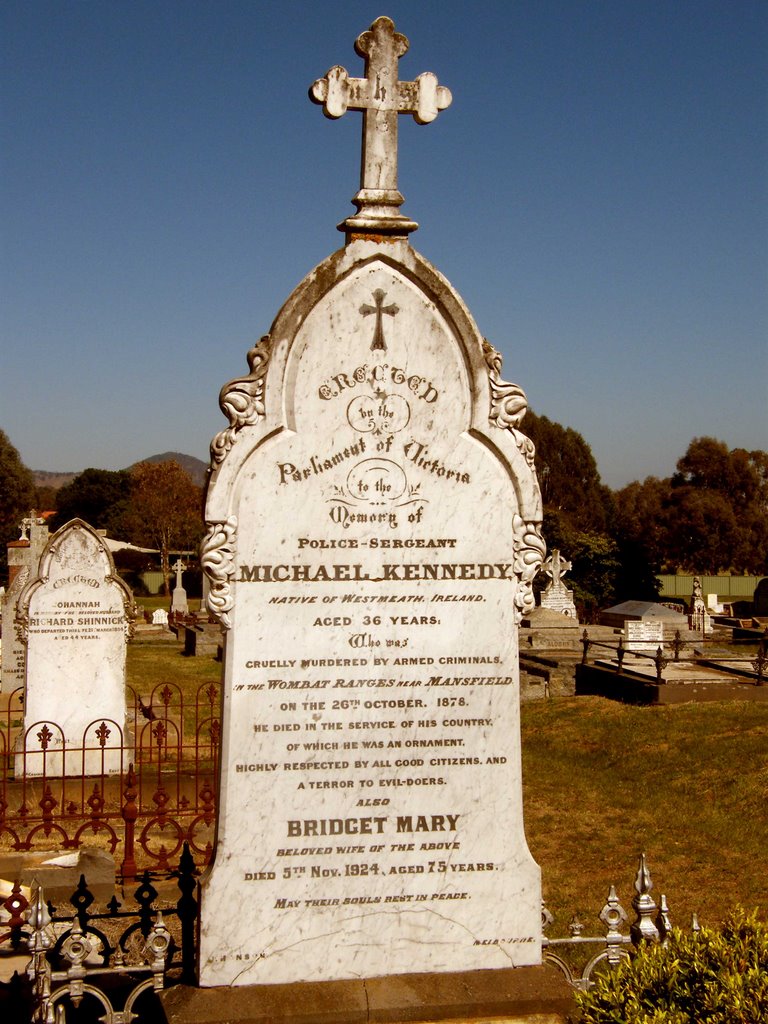
The ‘Welcome’ sign at the Stringybark Creek Historic Reserve says:
“It was here on the evening of Saturday 26th October 1878, that three policemen were shot and killed.”

The Victorian Police Blue Ribbon Foundation said on Facebook on 26 February 2017:
Today, 26 October 2017 marks the 139th anniversary of the police killings at Stringybark Creek, regarded as the worst single incident of police killing in Victorian history.
Sergeant Michael Kennedy and Constables Thomas Lonigan and Michael Scanlon were gunned down by Kelly and his band of outlaws at Stringybark Creek.
These three men hold a sacred place in Victoria police history as do the 156 other Victorian police officers killed in the line of duty.
The Victorian Police Museum and the National Police Memorial should ensure the significant historical date is correct.
Back on Track …
A Brief Account of the Events Surrounding the Notorious Ambush at Stringybark Creek
Volumes have been written over the years about the unfolding of events at Stringybark Creek. This is a brief account.
The Dinner, the Shovel, the Bullet and the Escape
The precipitating factor to the fatal ambush was the shooting of Constable Alexander Fitzpatrick who on 15 April 1878 went to the Kelly home to arrest Dan, Ned’s younger brother, for horse stealing.
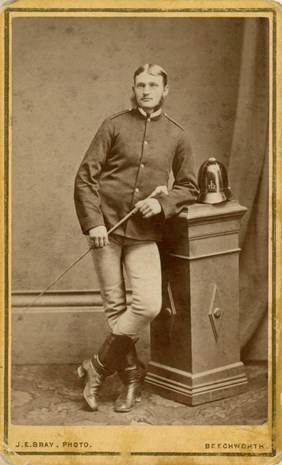
The Dinner
Instead of taking Dan back to the station immediately Fitzpatrick allowed Dan to finish his dinner. Big mistake.
The Shovel
Mrs Kelly, not happy about Dan being arrested and thinking she’d been duped by Constable Fitzpatrick on the reason for his visit, took to him with a fire shovel. Ned suddenly appeared at the door and fired a warning shot as Mrs Kelly struck her first blow pushing Fitzpatrick’s helmet down over his eyes. Temporarily blinded and flaying his arms trying to fend off another blow to his head, Fitzpatrick didn’t fend off a bullet fired from Ned’s gun which lodged in his wrist.
The Bullet
Ned knew there would be trouble because he’d shot a cop and his mother had wilfully assaulted a cop. He artfully insisted on removing the bullet from Fitzpatrick’s wrist and asked his mother to bandage the wound, not in a moment of kindness but to dispose of crucial evidence.
Ned let Fitzpatrick go but only after telling him that his life would be worthless if he revealed who had shot him, even coming up with a few stories to help Fitzpatrick explain the gun shot wound.
The Escape
With his revolver, horse and handcuffs returned Fitzpatrick made a quick exit and rode hard to the nearest town, Winton. There were two horse riders after him. It was obviously a short-lived reprieve and Fitzpatrick rode for his life.
He finally made it back to Benalla and told the story that Ned Kelly had tried to kill him. Warrants were soon out. One against Ned for attempted murder. The others against Mrs Kelly, Dan Kelly, and two other men present at the time, Bill Skillion and Brickey Williamson.
Ned and Dan headed for the hills.
The Bush Telegraph, the Police Search and the Parrots
Weeks and months drifted by and despite a £100 reward for anyone providing information leading to Ned Kelly’s arrest, information was not forthcoming.
The Bush Telegraph
The bush telegraph was alive with agents and informers from both sides – the police wanting information on the Kellys’ whereabouts and the Kellys’ on police movements.
The police intelligence however was no match for the Kelly network. This was Kelly country after all. The Kelly’s, the Lloyd’s, the Wright’s and the Quinn’s, all related, had tracts of land in the Wombat Ranges ostensibly in the job of cattle breeding.
Eventually police received a reliable tip-off about where the Kelly brothers were hiding out. It was now October, six months after the Fitzpatrick incident.
The Police Search
Confident of finally nabbing Ned and Dan Kelly two police search patrols were organised. One would leave Greta and the other Mansfield, at dawn on Friday 25 October 1878.
The Mansfield party included Police Constables, Thomas Lonigan, Michael Scanlan and Thomas McIntyre under the leadership of Sergeant Michael Kennedy. Someone watched the Mansfield party leave. McIntyre noticed but couldn’t tell who it was – a Kelly informer probably.
The party found a campsite on Stringybark Creek in the afternoon but little did they know the campsite was only one mile from where Ned and Dan Kelly were hiding out. And little did they know the brothers had strengthened their resources with two additional associates, Steve Hart and Joe Byrne, old prison mates. This was the Kelly Gang.
Kennedy and Scanlan started patrolling the following morning leaving Lonigan and McIntyre to hold fort at the campsite. The two left behind set about doing some camp chores – Lonigan tended the horses and McIntyre did some campfire cooking.
The Parrots
Lonigan became jumpy when he thought he heard a sound from the creek. McIntyre picked up a shotgun and went to investigate. He found nothing except some lorikeet parrots which he fired at thinking they’d be good tucker. Big mistake. The sound of the gun shot alerted the nearby Kelly gang.
The Ambush, the Murders and the Escape
Still jumpy, Lonigan decided to strap his revolver to his side. McIntyre put the shotgun in the tent where his revolver was and went back to his cooking.
The Ambush
“Bail up! Throw up your arms!” This wasn’t a joke as McIntyre first thought. This was the Kelly gang, armed with rifles and shotguns, approaching from the tall grass on the edge of the campsite. Kelly had a rifle poised to shoot. McIntyre, unarmed, threw his arms out immediately in surrender, Lonigan however made a run for it while trying to release his revolver.
The Murders
Kelly shot the running Lonigan through the eye and he died almost instantly. His last words: “Oh Christ! I’m shot!”
Horses were heard approaching the camp later in the afternoon. It was Kennedy and Scanlan returning. McIntyre, knowing Kelly had a rifle aimed at his back, did as he was instructed and moved towards his colleagues to tell them to surrender. Before he could say anything Ned appeared from behind a log and yelled out: “Bail up! Hold up your hands!”
Thinking it was Lonigan playing a joke, Kennedy made a jovial reach for his revolver. Kelly fired from his rifle. Kennedy realising what was happening dismounted from his horse on the side opposite Ned to surrender. At the same time the three other gang members came from the bush firing.
Scanlan stumbled as he dismounted, fell over, recovered, ran for cover, but tripped and fell again. He was shot by Ned Kelly while on his hands and knees.
Kennedy ran but was chased into the bush where he was mortally wounded and then finished off by Kelly with a gun shot to the chest at close range. Ned Kelly was taking no prisoners that day, but the gang however, took whatever personal valuables they could find, including Lonigan’s wedding ring, Kennedy’s heirloom pocket watch and money.
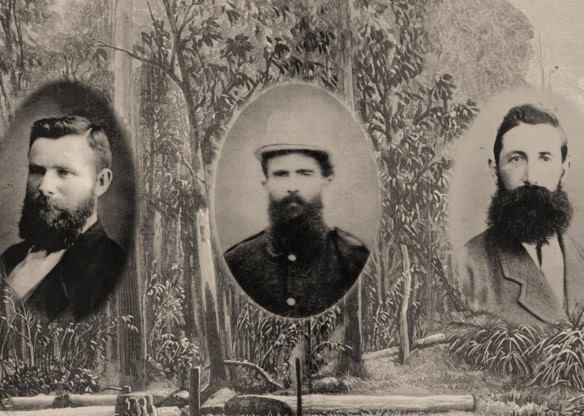
The Escape
McIntyre took advantage of Kennedy’s horse galloping towards him in fright. He jumped on and rode off in a hail of bullets one of which hit the horse. It was a daring escape. McIntyre was the only witness to Kelly’s murderous crimes at Stringybark Creek and without him the story would never be told, or worse, the fate of the policemen may have remained a mystery forever.
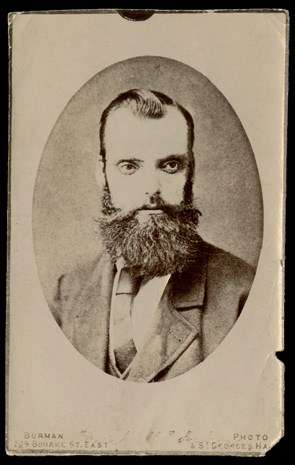
Tracking Down Ned Kelly to the Greta Cemetery and a History Scoop
Having soaked in the information and the sombre atmosphere at Stringybark Creek, we called it a day and started our drive back to Wangaratta. No phone signal. No Google Maps. Once again we were navigating blind. Fortuitously we turned left on to the Tatong-Tolmie Road and then right on to the Wangaratta-Kilfeera Road which took us past the Greta Cemetery. It was a serendipitous moment as we hadn’t planned a cemetery visit. But given we were tracking down Ned Kelly the opportunity couldn’t be ignored. I knew Ellen, his mother, was buried there.
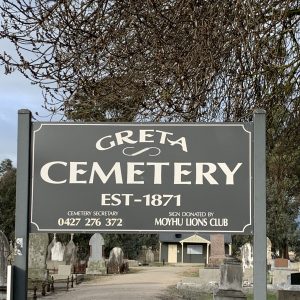
Two men were standing at the entrance gate, one in fluoro. He looked like a man in authority so I asked him if he knew where we’d find Ellen Kelly’s grave. In a friendly way he said he did, but couldn’t tell us because the Kelly family wanted it to remain private. He pointed to the Kelly family headstone at the gate.
Whose name stood out? ‘Edward Kelly’.
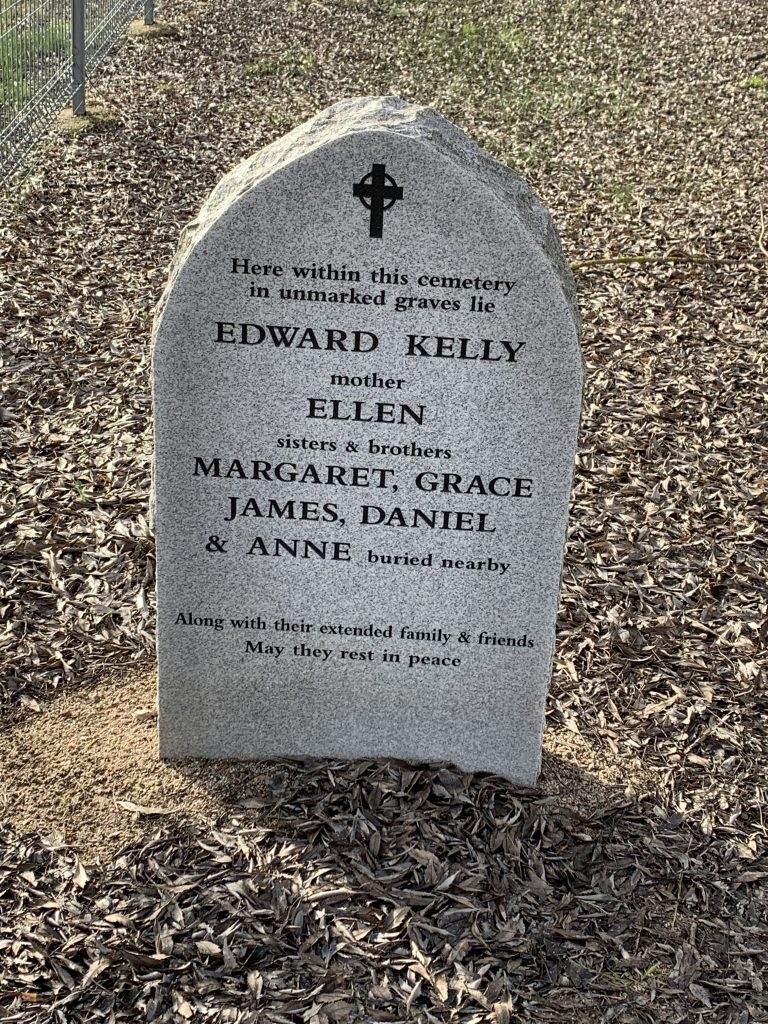
Ned Kelly Finally Buried in the Greta Cemetery Thanks to Some Gruesome Events and DNA
Ned is now buried in the Greta Cemetery along with his mother, brother Dan and other family members. All in unmarked graves. This is his final resting place thanks to the unearthing of a coffin at the Old Melbourne Gaol site in 2002, a missing skull and modern forensic medicine, specifically DNA testing.
One of Ned’s final wishes was to be buried in consecrated ground with other family members. Of course this wish was not granted after he was executed on 11 November 1880. It took another 132 years for his wish to come true. However a chain of gruesome events after his execution were key to his final burial at Greta.
What Happened to Ned after His Execution at the Old Melbourne Gaol?
Immediately after his death, Ned’s face and head were shaved and a death mask made, a macabre practice at the time, for the dubious science called phrenology.
I later discovered that the primary purpose was for a Mr Maximillian Kreitmayer, owner of the Melbourne Wax Works Museum, to take a plaster cast for a future exhibit. His head was phrenologically examined concurrently.
His body was then taken to the university, cut open and his head severed, for the benefit of medical students. Every organ examined.
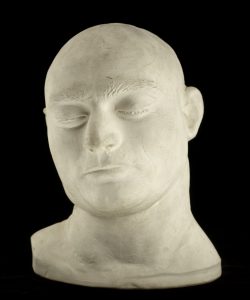
After that his body was placed in a crude wooden box made of red gum and unceremoniously buried at the Old Melbourne Gaol in a long rectangular area surrounded by blue-stone walls “built to last centuries”. The initials “E.K”, with an arrow, were later etched into the wall.
Here he laid for nearly 50 years along with other notorious criminals, until an excavator started removing the wall to prepare the ground for a new building, an engineering school for the Working Men’s College.
The Great Excavation
Mr H Lee of Contractors Lee and Dunn was aware the excavating was getting close to Kelly’s grave as workers had earlier seen a stone marked with the initials ‘E.K’ in the area. Hell broke loose when, on 12 April 1929, the lip of a steam shovel tore the lid off Ned’s coffin revealing an intact skeleton. The skeleton wasn’t intact for long.
Souvenir Hunters
There was a wild rush of workmen and onlookers grabbing at bones. Mr Lee managed to secure Ned’s skull but only after souvenir hunters had removed most of the teeth.
Despite Ned’s notoriety and murderous ways, the community at large was outraged by the ghoulish behaviour and condemned the desecration of his grave and skeleton. After all, he did suffer the ultimate punishment.

Ned’s remains were the first uncovered and desecrated. And yet no safeguards were implemented to stop raiders looting the second coffin belonging to wife murderer Frederick Deeming, executed in 1892.
According to Penal Department records, 27 criminals were buried in the area after 1880. (SMH, 18 April, 1929). So, if Ned’s skeleton was intact, as was Deeming’s, so too would the others.
Premier Wanted Answers
Premier, Sir William McPherson, rightly asked, why there was no provision made for removing their remains before building operations began.
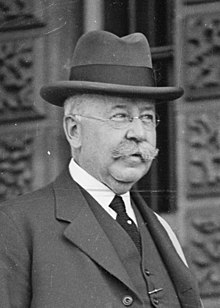
The short answer … the executed criminals were buried in quick lime which would, according to experts at the time, destroy both flesh and bones. So the expectation was that the bodies would have disappeared by 1929.
Quick Lime Not So Quick
One corpse still had flesh clinging to bones 18 years after being buried. Clearly the quick lime hadn’t done its job and State Cabinet hurriedly decided that all remaining graves would be reopened and the coffins removed to Pentridge Gaol.
Many of Ned’s stolen bones were voluntarily returned following official Government warnings of prosecution. Others were recovered by detectives.
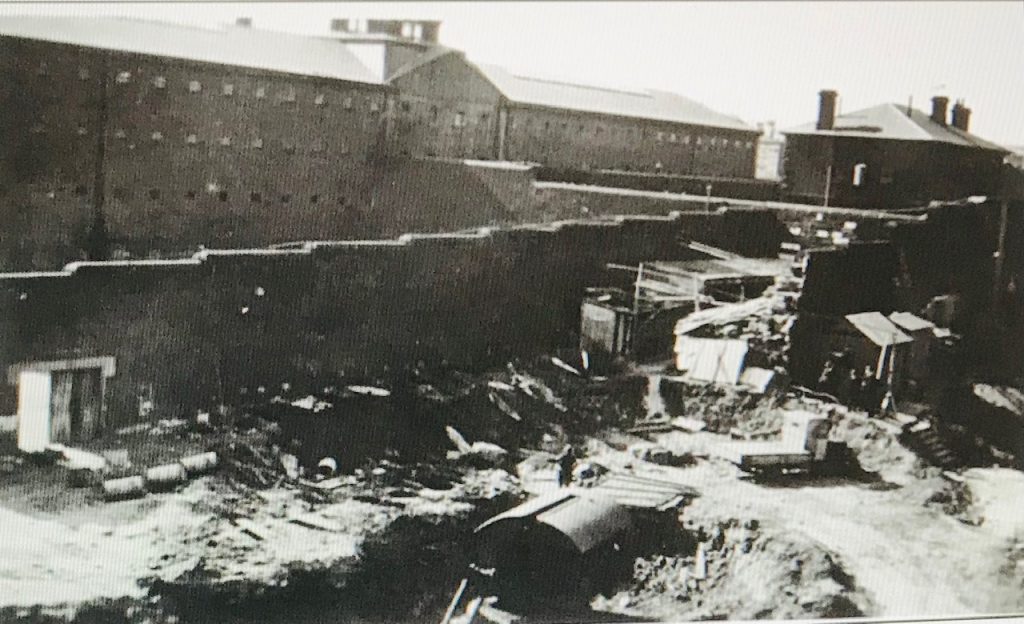
Chaotic Scenes – Skeletal Bones, Scattered Sacks, Stench and a Strike
Going by newspaper reports, chaotic scenes prevailed at the excavation site with bones being thrown into sacks and left lying about. The stench arising was so bad, according to ‘Labor Call‘:
” … that health authorities should have intervened and compelled the authorities to use disinfectant.”
After Mr P.J. Smith, Secretary of the Builders’ Labourers Union visited the site he said:
“As far as I could ascertain there has been no attempt to identify the remains, which have been placed in sacks about the place. The arrangements are gruesome, and for this the Government must take the blame.” (Herald, 18 April 1929, p 2)
He described conditions as a menace to the workers’ health. They were the most revolting he had ever experienced on a building job and withdrew his men from the site.
Work resumed after workers reached a pay deal of 30/- a day along with assurances that an undertaker would remove the bodies.
Bring in the Undertaker
Mr. Josiah Holdsworth, undertaker from Lygon street Carlton, was quickly appointed to supervise the work of clearing the graves. He advised that the excavation work should continue in the area but when workers came to a grave, expert grave diggers would take over to remove the bones and place them in coffins.
Remains Transferred to Pentridge
More Coffins Unearthed at Old Melbourne Gaol Site in 1937 and 2002
Pentridge Prison Closed, Sold and Burial Ground Forgotten
Remains of the historically notorious criminals and their burial site at Pentridge were all but lost as time passed. Come 1 May 1997 the prison officially closed. Come 1999 the prison was sold by the State Government to a private developer. The location of the old graves seemed a forgotten issue. That is, until Heritage Victoria stepped in after La Trobe University’s archaeological team researched the history of the single burial, unearthed at the Old Melbourne Gaol site (now part of RMIT) in 2002.
Tracking Down Ned Kelly at Pentridge
Researchers found a hand drawn prison burial layout showing three large mass graves and one smaller one. These graves were the reburial sites of the bodies from Old Melbourne Gaol in 1929 and 1937 respectively. Ned Kelly was listed as being buried in one of these mass graves.

March 2008 – Archaeologists Brought In
Exactly where the burial ground was however, remained a mystery until TerraCulture, a private heritage/archaeological firm, investigated and pinpointed the location.
TerraCulture gained approval to exhume the bodies in March 2008. Their brief from the Human Services Department and State Coroner was to:
” … establish whether the individuals interred in the burial ground at Pentridge could be identified, and to record all significant features of the burials. Any remains that could not be positively identified were to be delivered to the coroner’s office. It was also determined that any remains that could be identified were to be exhumed from the burial ground and re-interred in the area at the end of the D Division building (where Ryan had been buried until his remains were exhumed and handed to his family in early 2008).” (Losing the Plot, 2020)
One Mass Grave Remained Missing
Despite their detailed investigation and exhumation work, TerraCulture failed to find a batch of bodies transferred from Old Melbourne Gaol in 1929. One mass grave remained unaccounted for. But not for long.
February 2009 Missing Grave Found – Forensics Brought In
“The plot (designated Pit C) contained two layers of burials, totalling twenty-four burial boxes. In some cases the remains of one individual were found to be spread across more than one box, with bones from the upper body located in one box and bones from the lower part in another. It is likely that the partial or nearly complete remains of approximately fifteen individuals were contained within these twenty-four burial boxes. The top layer of Pit C consisted of eleven wooden boxes, three medium-sized coffins and one small coffin. The bottom layer contained six wooden boxes and three coffins.” (Losing the Plot, 2020)
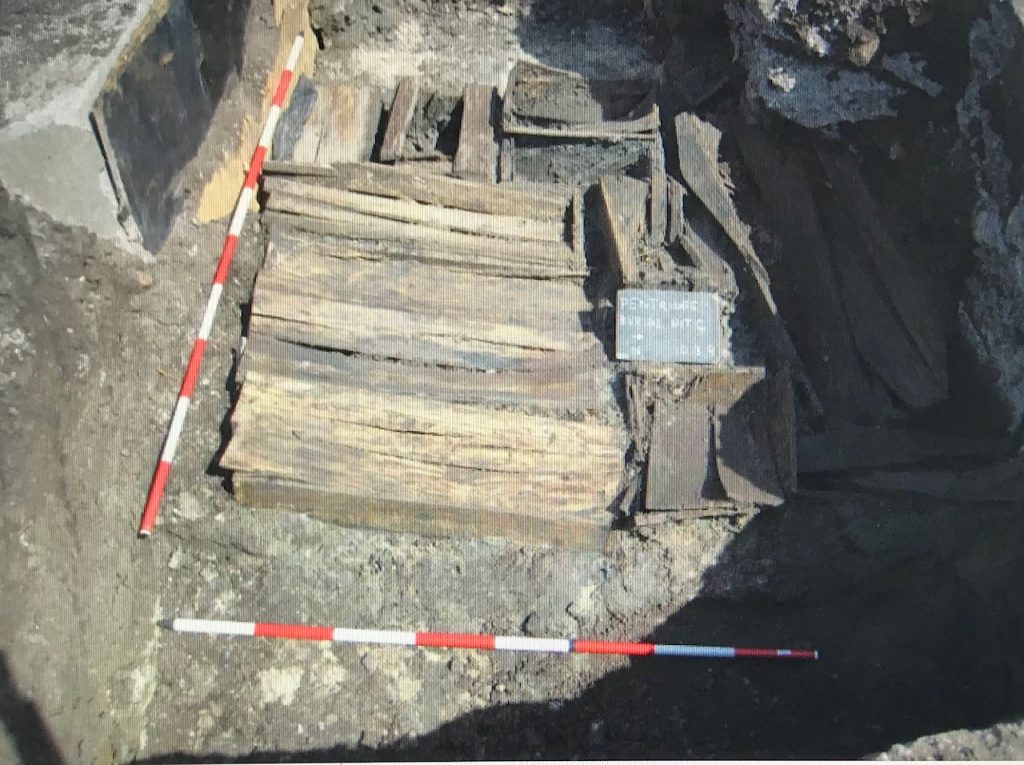
There were 17 boxes in this pit and seven coffins containing human remains. The boxes were industrial boxes, four of them used by an American tool company to export axe handles to Australia. These boxes contained human remains which appeared to be the first lot of bodies, including Kelly’s, exhumed before the professional undertaker stepped in to better manage the process. The undertaker probably used new coffins for the exhumed remains rather than pre-used boxes. (Losing the Plot, 2020)
September 2011 Ned Kelly’s Headless Skeleton Identified
Eventually, after 20 months, skeletal remains found in one axe box were identified as Ned Kelly’s. Doctors and scientists at the Victorian Institute of Forensic Medicine (VIFM) identified his remains using DNA taken from a descendant of his sister, Ellen. Ned’s skull however was, and still is missing.
It was a significant moment in Victoria’s history when the Attorney General announced in September 2011 that Ned Kelly’s remains had been officially identified. Most of the prisoners Kelly was buried with remain unidentified.

What happened to Ned’s Skull?
What happened to Ned’s skull? The short answer is, no one knows exactly. The bodies of executed criminals became the property of the Crown. After Ned was executed his body was subjected to some deplorable invasions by other humans, all sanctioned by the Government.
Plaster Cast and Phrenology
Pseudo ‘Professor’ Archibald Hamilton, known collector of skulls, was denied first access to Ned’s skull for a phrenological examination. Mr Maximillian Kreitmayer was given that honour and was the first person to get his hands on Ned. Kreitmayer had permission to take a cast of Ned’s head in preparation for a display in his waxwork’s museum in Melbourne. He was the one who shaved Ned’s head and took the plaster cast as early as he could while Ned’s facial features were in as natural a state as possible.
Hamilton however, was present with Kreitmayer and doing his phrenology work at the same time as Kreitmayer was taking the cast. Hamilton’s phrenological character report appeared a week later in the Melbourne Herald.
Medical Students
Next it was over to the university medical students for them to have their way. It is here that his head was believed to be severed and his every organ examined. The Melbourne Herald reported that:
“The skull was taken possession of by one gentleman, and it is probable that he may hereafter enlighten us upon the peculiarities of the great criminal’s brain.”
Who was this gentleman? Was it Hamilton, the skull collector?
Exhumations and the Skull’s Movements
During the early days of the 1929 exhumations Mr Lee, the contractor, rescued Ned’s skull from looters. He also apparently rescued the skulls belonging to Frederick Deeming, wife murderer; Frances Knorr, the baby farmer and Martha Needle, husband killer, during the period of disarray at the excavation site. Mr Lee said he would hand over Ned’s skull to police for the university. Presumably he handed over the other three as well.
The Australian Institute of Anatomy, Canberra 1931-1971
Around 1931 it seems the skulls were handed over to Sir Colin McKenzie who had just established the Australian Institute of Anatomy in Canberra. Here Ned’s skull (with ‘E. Kelly’ written on the temple) was put on display and was a draw card until it was removed in the 1940s. The skull went missing for a period and resurfaced in an old safe during some clearing out in December 1952.
Old Melbourne Gaol Museum, Melbourne 1971-1978
In 1971 ‘Ned’s’ skull was sent back to Melbourne for display at the Old Melbourne Gaol museum, managed now by the National Trust. The skull was stolen from its display case in 1978 and not heard of again until 2008 when TerraCulture archaeologists found the old burial site at Pentridge Gaol.
Thomas Baxter
Soon after the burial site was found, a Western Australian farmer, Thomas Baxter, contacted Heritage Victoria to say he knew the whereabouts of Ned Kelly’s skull. At the time a mass grave was still missing at Pentridge. In February 2009 the missing grave was stumbled on during trench digging at the Pentridge site and the VIFM was brought in to analyse the remains in the grave.
Mr Baxter delivers ‘Ned’s’ skull to the State Coroner on 11 November 2009, the 129th anniversary of Ned’s execution.
Coroner’s Verdict
In September 2010 the State Coroner announces that the skeletal remains in the missing grave were those of the executed prisoners from Old Melbourne Gaol. The Victorian Attorney General then announces funding for forensic profiling and testing of all the remains that were relocated from Old Melbourne Gaol to Pentridge in both 1929 and 1937.
Forensic Results
Ned Kelly’s skeletal remains were positively identified using DNA from Leigh Olver, the great grandson of Kelly’s sister, Ellen. The skull brought in by Thomas Baxter, and always believed by him to be Ned’s skull, was NOT a match.
So Ned Kelly’s skull is still missing and it has probably been missing from the day he was executed.
Ned Kelly’s Skeletal Remains Returned to His Family
Ned was given a dignified family send off on 18 January 2013. After a private memorial service at St Patrick’s Roman Catholic Church, Wangaratta, Ned’s remains were taken to Greta Cemetery where he was buried alongside his mother, brother in crime Dan, and other family members, in an unmarked grave. An understandable decision given the shambolic way his remains had been handled from the time of his execution.
The Man Who Reburied Ned Kelly – History Scoop
It turned out that the man in fluoro was the man who reburied Ned Kelly at Greta Cemetery. And, he was about to bury another member of the Kelly clan at the very time we found ourselves at Greta Cemetery, mid afternoon on 16 June 2022. What a day it had been for us in Kelly country where we ended up tracking down Ned Kelly to his final resting place. However, I’m not sure he will rest in peace until his skull is found.
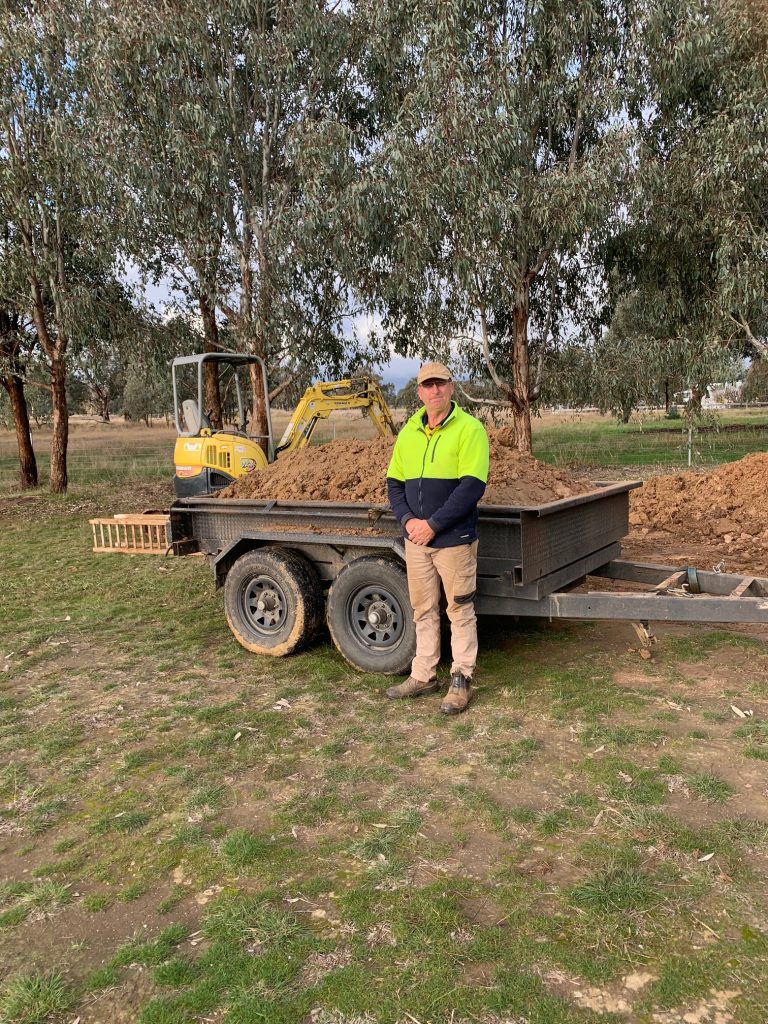
Sources and Links
Dufty, David (2022), Nabbing Ned Kelly, Allen & Unwin.
Medway, Kerry (2013), Is Ned Kelly In Heaven? Aussie Afire Publishing.
Trove, National Library of Australia
Australian Dictionary of Biography, National Centre of Biography, Australian National University
Smith, Jeremy (2020), ‘Losing the Plot: Archaeological Investigations of Prisoner Burials at the Old Melbourne Gaol and Pentridge Prison’, Provenance: The Journal of Public Record Office Victoria, issue no. 10, 2011. ISSN 1832-2522. Copyright © Jeremy Smith, Public Records Office Victoria Losing the Plot
https://www.youtube.com/watch?v=ajROPBoE75o – Police talking about the memorial
https://victoriancollections.net.au/items/529561312162ef1930ebcd59 – photo of Michael Kennedy’s body
https://www.theage.com.au/national/victoria/ned-kelly-setting-the-story-straight-at-stringybark-creek-20181205-p50kck.html article by John Silvester
https://adb.anu.edu.au/biography/kelly-edward-ned-3933 – great links in this article in the ‘Endnotes’.
https://trove.nla.gov.au/newspaper/article/199693863?searchTerm=ned%20kelly – The Mansfield Outrage
https://trove.nla.gov.au/newspaper/article/5919040?searchTerm=ned%20kelly – The Police Murders
https://trove.nla.gov.au/newspaper/article/199692540?searchTerm=ned%20kelly – The Bushranging Outrage
https://trove.nla.gov.au/newspaper/article/147319791?searchTerm=ned%20kelly – The Police Tragedy (good background plus Gazette notice)
http://classic.austlii.edu.au/au/legis/vic/hist_act/faa1878214/ – The Felons’ Apprehension Act 1878 – Ned and Dan could be shot on sight. Came into force on 1 November 1878.
http://www2.slv.vic.gov.au/collections/treasures/jerilderieletter/jerilderie00.html – The Jerilderie Letter
https://find.slv.vic.gov.au/permalink/61SLV_INST/s6pvau/alma9917779973607636 – Kreitmayer, M. L. (n.d.). [Death mask of Ned Kelly] [realia]. Kreitmayer, M.L was the maker of the death mask.
https://cv.vic.gov.au/stories/a-diverse-state/ambush-ned-kelly-and-the-stringybark-creek-murders/the-fitzpatrick-incident/ – Photo of Constable Fitzpatrick.
https://www.findagrave.com/memorial/142539216/alexander-wilson-fitzpatrick – Birth and death date of Fitzpatrick b. 18 February 1865, d. 6 May 1929.
https://cv.vic.gov.au/stories/a-diverse-state/ambush-ned-kelly-and-the-stringybark-creek-murders/the-search-party/ Photos of Search Party
https://www.smh.com.au/national/ned-kelly-finally-laid-to-rest-20130118-2cyxr.html Ned Kelly’s headless remains are shown in Melbourne by the Victorian Forensic Medicine in this September 1, 2011 file photo.
https://overland.org.au/previous-issues/issue-211/feature-jill-dimond/
https://www.abc.net.au/news/2011-09-01/ned-kelly-remains-found/2865298 – Finding Ned Kelly’s remains minus his skull.
https://www.abc.net.au/news/2018-11-11/ned-kelly-skull-location-remains-a-mystery/10476666 – Mystery of skull. Thomas Baxter.
https://www.youtube.com/watch?v=fn49_OuY57U – Prof. John Moloney interview
http://www3.slv.vic.gov.au/latrobejournal/issue/latrobe-69/t1-g-t8.html- Explaining the Death Mask.
